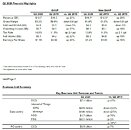- Joined
- Oct 9, 2007
- Messages
- 47,890 (7.38/day)
- Location
- Dublin, Ireland
| System Name | RBMK-1000 |
|---|---|
| Processor | AMD Ryzen 7 5700G |
| Motherboard | Gigabyte B550 AORUS Elite V2 |
| Cooling | DeepCool Gammax L240 V2 |
| Memory | 2x 16GB DDR4-3200 |
| Video Card(s) | Galax RTX 4070 Ti EX |
| Storage | Samsung 990 1TB |
| Display(s) | BenQ 1440p 60 Hz 27-inch |
| Case | Corsair Carbide 100R |
| Audio Device(s) | ASUS SupremeFX S1220A |
| Power Supply | Cooler Master MWE Gold 650W |
| Mouse | ASUS ROG Strix Impact |
| Keyboard | Gamdias Hermes E2 |
| Software | Windows 11 Pro |
Intel Corporation today reported second-quarter 2020 financial results. "It was an excellent quarter, well above our expectations on the continued strong demand for computing performance to support cloud-delivered services, a work- and learn-at-home environment, and the build-out of 5G networks," said Bob Swan, Intel CEO. "In our increasingly digital world, Intel technology is essential to nearly every industry on this planet. We have an incredible opportunity to enrich lives and grow this company with a continued focus on innovation and execution."
Intel achieved record second-quarter revenue with 34 percent data-centric revenue growth and 7 percent PC-centric revenue growth YoY. These results were driven by strong sales of cloud, notebook, memory and 5G products in an environment where digital services and computing performance are essential to how we live, work and stay connected.

News Summary:
The PC-centric business (CCG) was up 7 percent YoY in the second quarter on notebook strength driven by the continued work- and learn at home dynamics of COVID-19, which also contributed to a volume decline in desktop form factors as demand shifted to notebooks. In the second quarter, Intel expanded its 10th Gen Intel Core processor line-up with the launch of new Core S and H series processors for desktop and mobile gaming as well as the new 10th Gen Intel Core vPro processors, which deliver uncompromised productivity and hardware-based security features for commercial PCs. The second quarter also marked the launch of Intel Core processors with Intel Hybrid Technology, code-named "Lakefield," which utilize Foveros 3D packaging technology and feature a hybrid CPU architecture for power and performance scalability.
Intel is accelerating its transition to 10 nm products this year with increasing volumes and strong demand for an expanding line up. This includes a growing portfolio of 10 nm-based Intel Core processors with "Tiger Lake" launching soon, and the first 10 nm-based server CPU "Ice Lake," which remains planned for the end of this year. In the second half of 2021, Intel expects to deliver a new line of client CPU's (code-named "Alder Lake"), which will include its first 10 nm-based desktop CPU, and a new 10 nm-based server CPU (code-named "Sapphire Rapids"). The company's 7 nm-based CPU product timing is shifting approximately six months relative to prior expectations. The primary driver is the yield of Intel's 7 nm process, which based on recent data, is now trending approximately twelve months behind the company's internal target.
View at TechPowerUp Main Site
Intel achieved record second-quarter revenue with 34 percent data-centric revenue growth and 7 percent PC-centric revenue growth YoY. These results were driven by strong sales of cloud, notebook, memory and 5G products in an environment where digital services and computing performance are essential to how we live, work and stay connected.

News Summary:
- Second-quarter revenue of $19.7 billion was up 20 percent year-over-year (YoY). Data-centric revenue grew 34 percent, accounting for 52 percent of total revenue; PC-centric revenue grew 7 percent YoY.
- Second-quarter GAAP earnings-per-share (EPS) was $1.19, up 29 percent YoY; non-GAAP EPS of $1.23 was up 16 percent.
- Year-to-date, generated $17.3 billion cash from operations and $10.6 billion of free cash flow and paid dividends of $2.8 billion.
- Accelerating 10 nm product transition; 7 nm product transition delayed versus prior expectations.
- Expecting full-year revenue of $75 billion; GAAP EPS of $4.53 and non-GAAP EPS of $4.85.
The PC-centric business (CCG) was up 7 percent YoY in the second quarter on notebook strength driven by the continued work- and learn at home dynamics of COVID-19, which also contributed to a volume decline in desktop form factors as demand shifted to notebooks. In the second quarter, Intel expanded its 10th Gen Intel Core processor line-up with the launch of new Core S and H series processors for desktop and mobile gaming as well as the new 10th Gen Intel Core vPro processors, which deliver uncompromised productivity and hardware-based security features for commercial PCs. The second quarter also marked the launch of Intel Core processors with Intel Hybrid Technology, code-named "Lakefield," which utilize Foveros 3D packaging technology and feature a hybrid CPU architecture for power and performance scalability.
Intel is accelerating its transition to 10 nm products this year with increasing volumes and strong demand for an expanding line up. This includes a growing portfolio of 10 nm-based Intel Core processors with "Tiger Lake" launching soon, and the first 10 nm-based server CPU "Ice Lake," which remains planned for the end of this year. In the second half of 2021, Intel expects to deliver a new line of client CPU's (code-named "Alder Lake"), which will include its first 10 nm-based desktop CPU, and a new 10 nm-based server CPU (code-named "Sapphire Rapids"). The company's 7 nm-based CPU product timing is shifting approximately six months relative to prior expectations. The primary driver is the yield of Intel's 7 nm process, which based on recent data, is now trending approximately twelve months behind the company's internal target.
View at TechPowerUp Main Site

